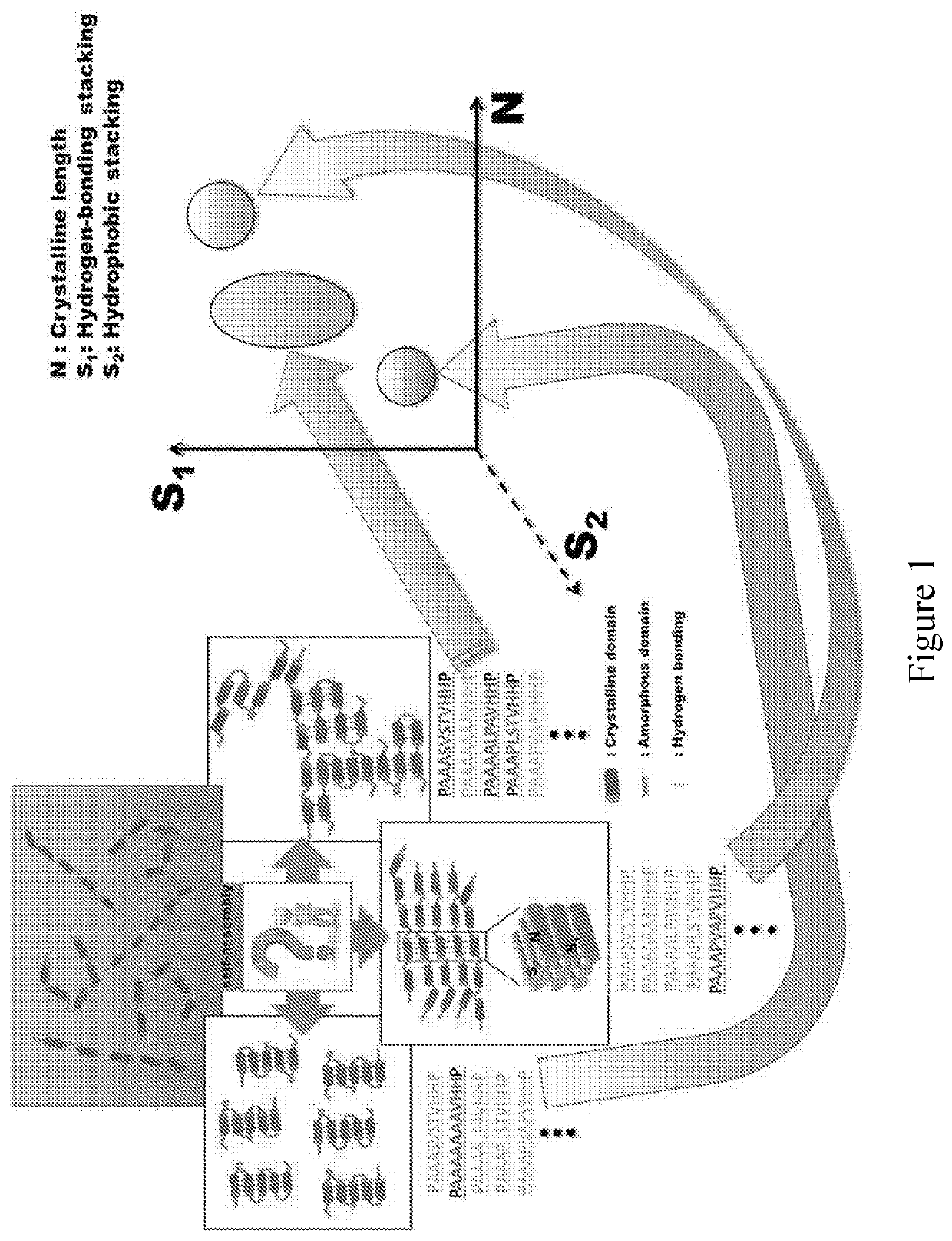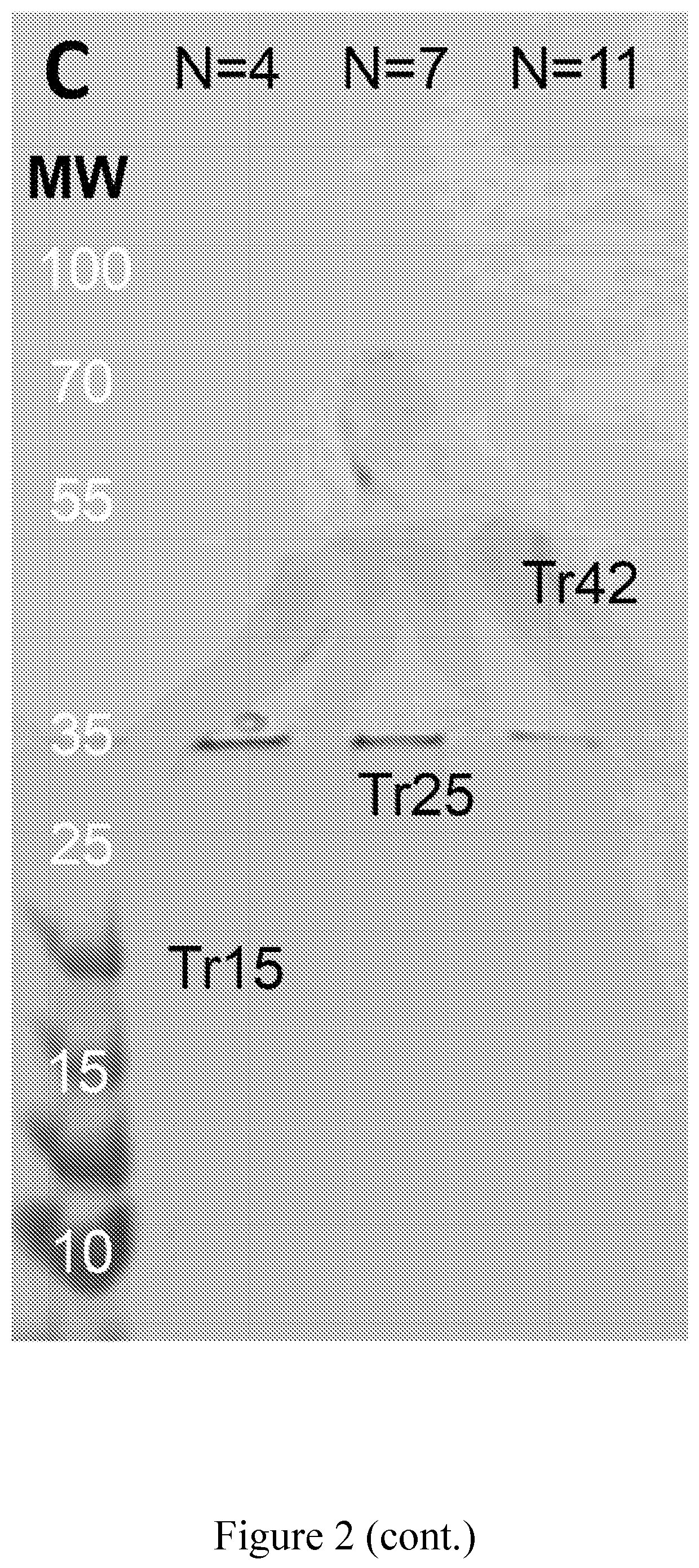Compositions and methods related to 2 dimensional molecular composites
a molecular composite and molecular composite technology, applied in the direction of peptides, crystal growth process, polycrystalline material growth, etc., can solve the problem that the polymers used in these studies lack supramolecular chemistry
- Summary
- Abstract
- Description
- Claims
- Application Information
AI Technical Summary
Benefits of technology
Problems solved by technology
Method used
Image
Examples
example 1
[0078]SRT proteins from Loligo vulgaris were identified using a next generation sequencing approach and transcriptome assembly (FIG. 3a). A segmented block is selected for tandem repeat construction strategy (FIG. 3b). Randomized gene libraries based on the block segment were designed and implemented as a combinatorial plasmid library by PCR and ligation. FIG. 3c shows the amplification strategy for producing tandem repeats the desired length, N, of the library members (e.g., DNA and protein gels for N=13 are shown in FIG. 3d). A description of a combinatorial library of crystalline-region variants is given below for the polypeptide termed SynE3.
example 2
[0079]Tunable mechanical properties are one of the key challenges for product development. Protein-based materials modified according to the present disclosure for including in 2D composite materials provide a solution to this problem due to the ease of molecular scale engineering. In fact, it is known that the toughness of semi-crystalline proteins increases with respect to number of β-sheets. Notably, fibrous proteins (e.g., silk and SRT proteins) contain hard and brittle crystalline domains and amorphous flexible regions. Each of these functional regions is assembled via hydrogen bonds and van der Waals forces. The backbones of these repeating units neatly align by forming a dense hydrogen bond network, resulting in two-dimensional β-sheets. Multiple β-sheets, in turn align in parallel to form a three dimensional stack of a few nanometers in size. Here, the hydrophobic forces play a major role by keeping the β-sheets together. Native SRT proteins already show considerable diversi...
example 3
[0086]In this example, we developed an alternative tandem-repeat DNA-assembly method to: (i) produce TR sequences of various lengths in a single reaction, (ii) offer better control over the resulting lengths, and (iii) allow pooled processing of unit-sequence libraries. In this approach, long TR products from a short sequence unit are produced by rolling-circle amplification (RCA). The RCA reaction is tuned to incorporate noncanonical nucleotides at random positions. These nucleotides block digestion by key restriction endonucleases; the resulting partial-digestion products can be separated by size and cloned into an expression vector for protein production. This method, which we call “protected digestion of rolling-circle amplicons” (PD-RCA), can be used to prepare a library of TR sequences with a controlled distribution of lengths in a single cloning step.
[0087]We applied PD-RCA and recombinant expression in E. coli to produce a panel of artificial SRT-based proteins that vary onl...
PUM
| Property | Measurement | Unit |
|---|---|---|
| diameter | aaaaa | aaaaa |
| distance | aaaaa | aaaaa |
| voltage | aaaaa | aaaaa |
Abstract
Description
Claims
Application Information
 Login to View More
Login to View More - R&D
- Intellectual Property
- Life Sciences
- Materials
- Tech Scout
- Unparalleled Data Quality
- Higher Quality Content
- 60% Fewer Hallucinations
Browse by: Latest US Patents, China's latest patents, Technical Efficacy Thesaurus, Application Domain, Technology Topic, Popular Technical Reports.
© 2025 PatSnap. All rights reserved.Legal|Privacy policy|Modern Slavery Act Transparency Statement|Sitemap|About US| Contact US: help@patsnap.com



